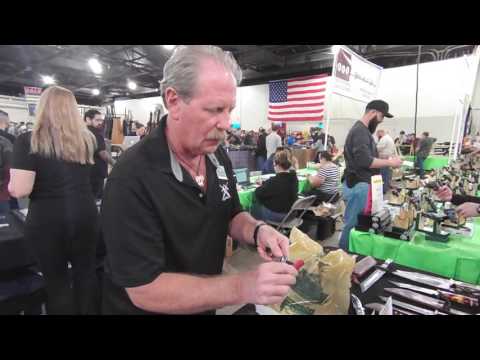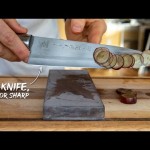
210b4a7d8e6ff55deaa872e43c266547
Having a sharp pocket knife is essential for a variety of tasks, from cutting rope to slicing fruit. But when it comes to sharpening a serrated pocket knife, the process can be a bit more complicated than sharpening a regular knife. In this article, we’ll provide a step-by-step guide to help you sharpen your serrated pocket knife quickly and easily. We’ll cover the tools you’ll need, the steps involved, and tips for getting the best results. So, let’s get started!
Can you sharpen a serrated pocket knife
Serrated pocket knives are a great tool to have on hand for a variety of tasks. They are especially useful for cutting through tough materials like rope, leather, and even wood. But like any other knife, they will eventually become dull and need to be sharpened. But can you sharpen a serrated pocket knife?
The answer is yes, you can sharpen a serrated pocket knife. However, it is important to note that sharpening a serrated pocket knife is a bit more complicated than sharpening a regular knife. This is because the serrations on the blade require special attention and care when sharpening. It is also important to use the right tools and techniques to ensure that the serrations are sharpened properly.
The first step in sharpening a serrated pocket knife is to use a sharpening stone or a sharpening rod. These tools are designed to sharpen the blade without damaging the serrations. It is important to use a light touch when sharpening the blade, as too much pressure can damage the serrations. Once the blade is sharpened, it is important to use a honing steel to realign the serrations and ensure that they are sharp.
Another option for sharpening a serrated pocket knife is to use a sharpening system. These systems are designed to sharpen both regular and serrated blades. They usually consist of a sharpening stone, a honing steel, and a guide to help you sharpen the blade correctly. These systems are a great option for those who are not comfortable sharpening a serrated pocket knife by hand.
No matter which method you choose, it is important to take your time and be careful when sharpening a serrated pocket knife. If done correctly, you can keep your knife sharp and ready for use for many years to come.
How do you sharpen a serrated knife
Sharpening a serrated knife is a bit different than sharpening a regular knife. Serrated knives have a unique blade with a saw-like edge that can be difficult to sharpen. However, with the right tools and techniques, you can sharpen your serrated knife and keep it in top condition.
Steps to Sharpen a Serrated Knife
Step 1: Gather the necessary tools. You will need a honing steel, a sharpening stone, and a cloth. You may also want to use a pair of gloves to protect your hands.
Step 2: Secure the knife. Place the knife on a cutting board or other secure surface. Make sure the blade is facing away from you.
Step 3: Start with the honing steel. Hold the honing steel in one hand and the knife in the other. Place the blade of the knife against the honing steel at a 20-degree angle. Pull the blade down the length of the honing steel, applying light pressure. Repeat this process several times.
Step 4: Move on to the sharpening stone. Place the sharpening stone on a flat surface. Hold the knife in one hand and the sharpening stone in the other. Place the blade of the knife against the sharpening stone at a 20-degree angle. Pull the blade down the length of the sharpening stone, applying light pressure. Repeat this process several times.
Step 5: Wipe the blade with a cloth. Use a clean, dry cloth to wipe the blade of the knife. This will remove any debris or residue that may have accumulated during the sharpening process.
Tips for Sharpening a Serrated Knife
When sharpening a serrated knife, it is important to use the right tools and techniques. Here are some tips to keep in mind:
- Always use a honing steel and sharpening stone specifically designed for serrated knives.
- Be sure to use a light touch when sharpening.
Too much pressure can damage the blade. - Sharpen each serration individually. This will ensure that each serration is sharpened evenly.
- Wipe the blade with a cloth after sharpening to remove any debris or residue.
With the right tools and techniques, you can easily sharpen your serrated knife and keep it in top condition. With regular sharpening, your knife will stay sharp and ready to use.
What file do you use to sharpen a serrated knife
Sharpening a serrated knife is a tricky task. It requires a special tool to get the job done properly. The most common tool used to sharpen a serrated knife is a file. A file is a metal tool with a rough surface that is used to sharpen and shape metal objects. It is important to use the right type of file for the job, as different types of files are designed for different tasks.
When it comes to sharpening a serrated knife, the best type of file to use is a diamond file. A diamond file is a type of file that is made from diamond particles. It is very hard and durable, making it perfect for sharpening serrated knives. The diamond particles on the file will help to sharpen the serrated edges of the knife, giving it a sharp and even edge.
When using a diamond file to sharpen a serrated knife, it is important to use the correct technique. Start by placing the file on the serrated edge of the knife and pushing it away from you. Move the file in a back and forth motion, making sure to keep the file at the same angle as the serrated edge. This will help to ensure that the serrated edge is sharpened evenly.
Once you have finished sharpening the serrated edge of the knife, it is important to check the sharpness of the blade. You can do this by running your finger along the edge of the blade. If it feels sharp, then the knife is ready to use. If it does not feel sharp, then you may need to repeat the sharpening process.
Sharpening a serrated knife can be a tricky task, but with the right tools and technique, it can be done easily. A diamond file is the best tool to use when sharpening a serrated knife, as it will help to sharpen the serrated edges evenly. With a little practice, you can easily sharpen your serrated knife and keep it in top condition.
Which side of a serrated knife blade you need to sharpen
Serrated knives are a great tool for cutting through tough materials, but they require special care when it comes to sharpening. Knowing which side of a serrated knife blade to sharpen is essential for keeping your knife in top condition.
The first step in sharpening a serrated knife is to identify the beveled side of the blade. This is the side that has a slight angle to it, and it is the side that should be sharpened. The other side of the blade is flat and should not be sharpened.
Once you have identified the beveled side of the blade, you can begin sharpening. It is important to use a sharpening stone or other sharpening tool specifically designed for serrated knives. This will ensure that the serrations are not damaged during the sharpening process.
When sharpening a serrated knife, it is important to use a light touch. You should not press too hard on the blade, as this can damage the serrations. Instead, use a gentle back and forth motion to sharpen the blade.
It is also important to sharpen the entire length of the blade. This means that you should sharpen each serration individually, rather than trying to sharpen the entire blade at once. This will ensure that the entire blade is sharpened evenly.
Finally, it is important to remember that serrated knives require more frequent sharpening than regular knives. This is because the serrations can become dull more quickly than a regular blade. Therefore, it is important to sharpen your serrated knife regularly to keep it in top condition.
Knowing which side of a serrated knife blade to sharpen is essential for keeping your knife in top condition. By following the steps outlined above, you can ensure that your serrated knife is always sharp and ready to use.
We hope this guide has been helpful in teaching you how to sharpen a serrated pocket knife. With the right tools and a bit of patience, you can keep your knife in top condition for years to come.
Thank you for reading, and goodbye!















